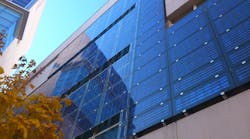The solar industry is anything but stagnant. Most folks not focused on this sector will find the technology decisions surrounding a solar installation today are much more complex than just a year or two ago. Along with ongoing developments in solar cell makeup, there are now more options with tracking devices and panel configuration. One of the newer developments is the use of bifacial panels.This trend raises a conundrum: When is being two-faced a good thing?
Let’s get our geek on and briefly review some of the developments in the solar sector. Anyone who has followed solar technology for awhile is aware that chemical structure and configuration of solar cells are key determinants of solar efficiency. A very high percentage of solar panels in use today are crystalline silicon (c-Si). The efficiency of the solar cell is increased as the purity of the silicon is increased. Over time, purification methods have improved and cost has declined, so that more pure monocrystalline silicon is becoming more competitive with the traditional polycrystalline silicon solar cells. Average efficiencies for mono- and polycrystalline solar panels are 17% and 14%, respectively.
Thin-film photovoltaic cells (TFPV) are another option with considerable promise. Because thin-film applications are made by applying one or more thin coats of photovoltaic material on a substrate, TFPV has practically unlimited potential for architectural materials. TFPV uses a variety of photovoltaic material options including amorphous silicon (a-Si), cadmium telluride (CdTe), copper indium gallium selenide (CIS/CIGS) and organic photovoltaic cells (OPC). Average TFPV panel efficiency is 9%.
The National Center for Photovoltaics (NCPV) at the National Renewable Energy Laboratory (NREL) in Golden, Colorado, is a leading center for PV research, development and outreach. NCPV regularly issues an efficiency chart that provides the latest reports regarding solar cell research efficiencies world-wide. That report can be found here: https://www.nrel.gov/pv/national-center-for-photovoltaics.html. Keep in mind that solar cells are tested under ideal conditions and that solar cell efficiencies are greater than solar panel efficiencies.
Many commercial solar installations today have single or dual axis tracking capability. However, such systems are becoming so prevalent that even residential systems and DIY applications can readily be found. The concept is straightforward. Solar radiation collection efficiency is maximized by maintaining an optimal alignment with the sun. A dual-axis tracking system adjusts azimuth, which allows the solar panel to move left and right and elevation which allows the panel to turn up and down. A dual axis system can increase panel energy efficiency by 20% or greater under a range of conditions.
Finally, we will mention bifacial solar panels, one of the latest developments. Bifacial panels have a clear backing, so they can produce power from both sides of the module, capturing direct and indirect sunlight. Like other solar panels, bifacial panels are affected by their orientation, panel spacing, temperature and also albedo or the amount of solar energy reflected off of a surface. For an interesting comparison of how bifacial and other panels performed under different environmental conditions, check out this article: https://www.greentechmedia.com/articles/read/who-wins-when-bifacial-thin-film-cdte-and-crystalline-silicon-face-off#gs._pTshJU.
Research has shown that bifacial panels exhibit an 11% higher energy yield than conventional panels. Solar panel developers believe that high efficiency bifacial panels with tracking are posed to achieve collection efficiency gains as high as 30%. Well, that sounds like we have one answer to our conundrum of when it is good to be two-faced. It’s when we are selecting solar panels and higher efficiency is desired.


